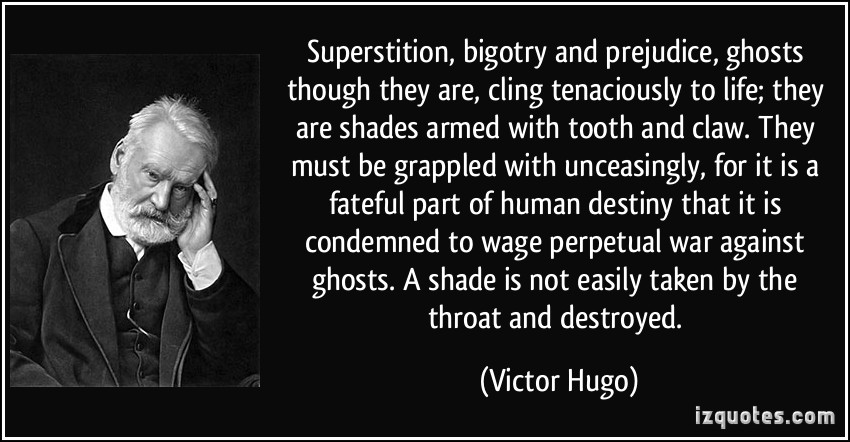
The Obvious: In our world, the bigotry of race and gender are obvious and they have long and painful histories. We all realize when someone is mistreated because of the color of their skin, bigotry has occurred. We all know stories of the pain caused by this bigotry. Similarly, we realize if someone is mistreated because of their gender, bigotry has occurred and we know the history of the denial of rights for women.
My question; are these two bigotries separate and independent or two faces of the same underlying problem? Because they have separate histories with different consequences in our history, they appear separate. Racist behavior and sexist behavior seem to be independent.
My understanding of myself has been helped by thinking of bigotry as one underlying problem with many faces-not just two. I want to briefly present that idea today. I will discuss how the idea has helped me in the future.

Definition: In the Merriam-Webster dictionary, a bigot is someone who regards or treats members of a group with hatred or intolerance. Obviously that applies to racist and sexist behavior. Intolerance for another race is bigotry. Intolerance for another gender is bigotry. The single underlying definition for both problems makes it possible– if not likely — that we have one underlying cause expressed in multiple ways. If viewed that way, bigotry becomes a singular problem with many faces.

Thanksgiving: I began to think of bigotry as a general problem after a particularly eventful Thanksgiving several years ago. Stuart, a student in several of my classes was from South Africa. I knew he would not be going home for Thanksgiving and so we invited him to our home for Thanksgiving dinner.
He was on the track team. He asked if he could bring two other members of the team who were also from a foreign country and would not be able to go home. I said “of course.” When the three showed up, the white South African student was accompanied by two black Kenyans.
I have asked many people – what did they expect to be the relationships between the three students? When I ask my question, people who believe race is the most important underlying structure in human relationships assumed the two blacks would get along better with each other than they would with the white student. The consensus particularly in the Deep South has been the two Kenyans would get along because they are black. The Kenyan-South African relationships would be strained because the white South African student had to be a racist because of apartheid. He had to have the disease of racism.
Most are surprised to learn the truth. The second language of the white South African was Zulu. He was raised with and was very comfortable around black people. He was very close to the Kenyan from Nairobi. The feeling of the Nairobi Kenyan toward the South African was mutual.

Tribal Bigotry: However the two Kenyans were from different tribes, different cultures; one from an inland tribe and one from Nairobi. The two Kenyans had a very tentative relationship. They were on the same track team and from the same country so there were some positive ties, but both Kenyans were well aware of the history of hatred between their two tribes. They were cautious in their friendship.
I began to see bigotry as multi faceted. Remember the definition of bigotry In the Merriam-Webster dictionary: a bigot is someone who regards or treats members of a group with hatred or intolerance. Historically the Kenyan tribes had hatred and intolerance between them. Clearly another face of bigotry was present between the two Kenyan tribes.
Historically many terrible consequences of racist actions have occurred; unfortunately tribalism has led to many similar evil consequences. Tribalism in Kenya has led to many deaths and other serious problems. As recently as 2008 an estimated 800 to 1500 people were murdered because of tribal unrest in Kenya. In 1994 in Rwanda an estimated 500,000 to 1 million people were killed in conflicts between the Tutsi and Hutu cultures.
Tribal bigotry is another very powerful determinant of behavior. Thus I began to think of bigotry as a force with many faces. I hope you will begin to consider thinking in a similar manner. Race, gender and tribes are but a few of the faces. I hope to show you many more faces and more importantly develop how my broader understanding of bigotry has helped me in my Christian journey.
Please note, I am not diminishing the negative consequence of racist or sexist behavior; I am broadening the destructive power of evil bigotry.
I will continue my development next week.
Until then
Peace
Jerry
2 Comments
Ian Linquist · November 15, 2019 at 8:01 pm
Hi there!
I just wanted to say I love the consistent work you put out, I read every single one.
Thank you for everything you do,
Ian
Jerry Williams · November 16, 2019 at 1:09 pm
Ian,
Great to hear from you. Thanks for your interest. If you ever have any thoughts, suggestions, questions or criticisms–please do not hesitate to offer them.
I hope your first semester is going well.
I will be in Boston in late January for a couple of Celtic games.
I am with a group, but if my schedule permits and you are up for it, I could buy your lunch!!
Jerry